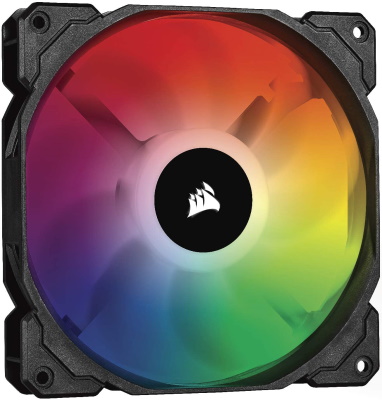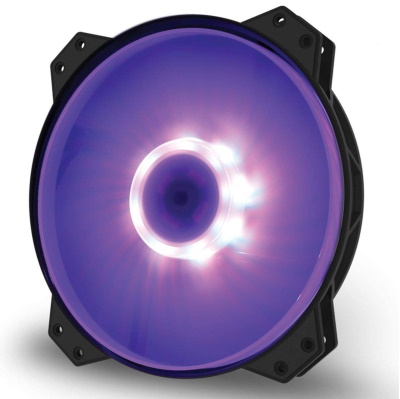🙋 Direct support and advice in our Telegram group
📹

Le fans, and in general theair that moves inside our pc, are a fundamental part for thehardware, absolutely not to be underestimated if you want to cool properly CPU e GPU and push a system hard even with theoverclock.
This world can, however, be a real confusion: there are many fans in online shops, but how do you choose them and to disentangle the various existing types?
If you are looking for a solution to improve the so-called airflow (the air current inside the case determined by the fans) of your pc, this is the guide for you.
We will talk about the prices, features and dimensions of the fans, so that every pc can finally ... take a breath ofair!
In the first part I will list the characteristics purely specifications of the fans, while we will then go to ananalysis detailed information on the products and their features, so that theairflow have no more secrets for your next one build.
- Best fans for pc • How to choose them?
- Best PC Fans • Static Pressure or Airflow?
- Best PC Fans • PWM (4 Pin) or DC (3 Pin)
- Best PC Fans • Dimensions (120mm, 140mm, 200mm)
- Best PC Fans • RPM and technical specifications
- Best PC Fans • The best 120mm fans
- Best PC Fans • The best 140mm fans
- Best PC Fans • The best 200mm fans
- Best PC Fans • Conclusion
PC fans • How to choose them?
We must first consider the features purely specifications of the fans in order to then go and choose the more ones affordable for your system.
Quiet PC Fans • Static pressure or airflow?
As written in the introduction, there are basically two types of fans: those static pressure and those airflow.
As the name implies, the fans static pressure they always move an equal quantity of air at the maximum possible speed.
They are very effective especially when placed in a case mesh accompanied by a dust filter or on heat sink of a heatsink a liquid all in one: this is because, with the same air flow, they will still effectively cool, despite the resistance due to the size of the material in front of them, in the face of greater noise.
The fans airflow, on the other hand, they are called this way because they are designed in such a way as to move as much air as possible, dissipating the air that is created inside the PC faster.
They perform best when placed in areas where meet no resistance in the air stream.
PC fans • PWM (4 Pin) or DC (3 Pin)
The two categories mentioned above are further divided into two sub-categories: PWM fans e DC fans.
The fans DC have an attack on 3 pin: 12v, grounding and signal, which make them controllable through the amount of current that is delivered to them by our system.
The fans PWM, on the other hand, they can be controlled directly from the bios thanks to a controller a 4 pin detto PWM (Pulse with modulation).
By setting the right curve you can make them spin more quickly when the CPU or chipset of ours motherboard I'm downstairs sforzo: they are therefore fans designed specifically to dissipate more quickly during a use charged.
They can also be set directly to the speed of your choice to make sure you reduce the noise.
PC Fans • Dimensions (120mm, 140mm, 200mm)
But that's not all, because there are commonly three on the market dimensions of fans: 120 mm, 140 mm e 200 mm: each dimension moves a different one amount of air based on size. There are also fans of different sizes, but extremely rare to find in PC day gamers.
You will typically always find houses with a combination of 2 fans: one on front and one on Retro, 120 mm or 140 mm. You can also decide to buy a case without any fan and take the ones you like best!
The main reason of choice, however, must always remain to ensure that the CPU and GPU do not overheat during use.
Quiet PC Fans • RPM and technical specifications
To make sure that everything goes as it should, therefore, it is always better to choose fans for the case equal between them, or even of different brands but with the same technical characteristics.
The first data to consider for the fans are the RPM: revolutions per minute, or if we want to translate better it is simply about revolutions per minute that the fan can perform.
The more a fan turns, however, the more it is noisy: fan manufacturers therefore do their utmost at an engineering level so that the right combination of performance and noise can be found, measured in decibel.
The displaced air is calculated instead through i cubic meters per hour, while the static pressure in millimeters per H2O.
As you may have guessed, the world of fans is made up of compromise.
So let's go see which fans the market offers and which of them you should choose.
PC Fans • The best and quietest 120mm fans
Let's start with the fans from 120 mm: the most common and traceable in many homes as well as compatible with most systems on the market.
Arctic BioniX P120

The basic version of the P120 is what you find in Freezer 34 esport Duo, what you may not know is that they can also be purchased individually.
The P120, like almost all home fans Arctic, have the great advantage of being designed specifically for the series connection (PST): each of them has a 4-pin split PWM which will save you having to buy separate splitters, making all the others pilot the first of the series.
La noisiness of the fan hovers around 24 db at the speed of 1000 rpm, a pretty good result that places it just behind the Noctua NF-A12, while theairflow given is 114,9 cubic meters per hour.
The cost of the 3 pack is definitely acceptable, considering that the competition has fans with these same characteristics at much higher prices.
Icing on the cake: the 10 warranty years Say Arctic.
Noctua NF-A12x25 Cromax

The Cromax are the “black” band of the now famous Noctua, an Austrian company renowned in the world of dissipation.
We are talking about a 120 mm fan that can be customized with small ones clip of plastic of different colors, which contains within it all the best that the tech Noctua has to offer us.
They are equipped with AAO (Advanced acoustic optimization), an anti-vibration structure designed by the Austrian company that combines rubber pads and a honeycomb retina that allows faster sliding of the fan) and the Flow Acceleration Channels (a particular relief on the fan blades that straightens the air flow).
It then goes up to RPM 2000 with an airflow of 102,1 cubic meters per hour, a static pressure of 2,34 mm and with a noise around 18 db in idle, sui 28 db a 1000 rpm and on 36,5 db at maximum speed.
Needless to say, as always, Noctua makes products for a few but worth every single penny if you are looking for an absolutely silent fan.
The Austrian manufacturer's warranty for its fans is 6 years.
ARCTIC BioniX P120 A-RGB

What I'm talking about now is a pack with 3 fans ideal for radiators.
Le BioniX P120 A-RGB will make all lovers of fairy lights happy, without forgetting quality and comfort: compared to the "basic" P120: we have a product that reaches 2300 rpm at maximum power, connectable with PST, with a static pressure given to 2,11 mm it's a airflow given to 85 cubic meters per hour.
La noisiness is the same as the younger sisters but surely what you will buy this pack for is the ability to customize the ice in ARGB.
Here too we have one of 6 years warranty, which will allow you to fully enjoy hours and hours of colored lights on your radiator or air cooler.
PC Fans • The best and quietest 140mm fans
The "state of the art" of dissipation are certainly the fans from 140 mm: the right compromise for excellent low noise performance, precisely because the size of the fan allows you to move more air without spinning too fast.
So let's go see which ones are worth buying.
ARCTIC P14 PWM PST CO

Le P14 they are the "big sisters" of P12.
Like her younger sister, the P14 is connectable in PST to other fans the same but guarantees a airflow di 123,76 cubic meters per hour and a static pressure of 2,4 mm.
The greatest attraction of this product is certainly the noisiness: only 22 db a 1700 rpm!
La P14 it's definitely a great product if you want performance above all else, For cool as much as possible the large radiator of your aio or why not, to ensure silence in the back of your case as well.
These beautiful fans enjoy a warranty of well- 10 years!
NOCTUA NF-A14 PWM CHROMAX BLACK

The Noctua NF-A14 is the increased version of the NF-A12.
Like the lower model, here too we rely on all the technology that Noctua can offer, with a maximum of RPM 1500 and guaranteed noise a 24,6 db even under intense workload.
THEairflow is measured at 140,2 cubic meters per hour, quite a bit ahead of the smaller version.
The special thing about the package is the Lna cable: Low Noise Adaptor. This is a technology that allows the NF-A14 to be transformed into a static pressure, limiting i turned to 1200 rpm, which will allow you to have unparalleled versatility and silence!
Obviously there is a small price to pay for having an impressive one 19 db of noise but you might be willing to make up for it if you want a fan in the back, on the top or behind a radiator with really interesting performances.
The NF-A14 pwm enjoy 6 years guarantee.
Corsair iCUE SP140 RGB PRO

After taking a leap into the engineering wonders of Germany and Austria, it is time for a raid in the world of Corsairs: an excellent alternative for LED lovers is precisely the Corsair iCUE SP140 RGB.
Efficient and illuminated, the excellent hydraulic mount guarantees a speed of 1150 rpm, but in the face of a 26 db constant.
However, we are in the order of 105 cubic meters per hour like airflow, and compared to a lot of competition we say that that of 26 db it's a price you can pay for a well-lit system!
Remember to obviously check that you have a hub in the case that allows you to connect more than one without problems, also because like all LED fans you will have both the 3 pin per dc than that to 4 pins for the RGB controller.
The guarantee is two years.
PC Fans • The best and quietest 200mm fans
The houses that host them are "special", you don't see so many around, they have some problems but they guarantee a crazy cooling ...
They are the fans from 200 mm! With 20 centimeters of fan it is possible to cool any system, however “nervous” the system may be processor at its center and however much it can be runaway Video Card.
There are pc fans so special, however, that there aren't many of them around: here are the two we have chosen to guarantee you a overclock.
Cooler Master MasterFan MF200R RGB

I am particularly fond of these fans because I have inserted them in my case but I have no doubt that you will like them too, if you are looking for a stable and aesthetically satisfying solution to dissipate.
We are talking about dc fans with a static pressure of 0,88 mm H2O and that they move well 152 cubic meters per hour as airflow, compared to 28 db as noise, highly inaudible unless you want a completely soundproof system at all costs.
To complete this excellent fan a guarantee of two years of Cooler Master and of course the rgb lighting which makes it very fascinating to see them inserted in a case.
Noctua NF-A20 PWM chromax.Black.Swap

The non-plus ultra of the most demanding, the top for those who want a cooling system without tamarre lights: le NF-A20 represent a huge arrival point for Noctua which, with this product, manages to combine efficiency and power with very little noise, thanks also to the fact that it is a fan PWM!
That's right, you can check their speed directly from the bios, deciding whether to leave them at fixed revolutions or adapt to temperatures of the cpu and the chipset.
Like the Cooler Masters we are up RPM 800 as maximum revs, with a airflow guaranteed a 146,9 cubic meters per hour… But facing alone 18 db di noise!
A truly incredible result due to the technologies of the Austrian brand, who designed this product for the most passionate pc builders.
To complete the work a guarantee of six years, against which even the price per single fan is justified.
PC Fans • Which to Choose?
There are plenty of solutions out there to cool your pc and I hope this little guide may have helped you decide which fans to add to your setup.
Always remember the difference between PWM e DC, the fun is up to you to find out which is the best solution for your system.
Just remember that usually front fans blow air into the system, the one behind or those on the top suck by throwing out the hot air (ditto if you use a radiator in the front or in the top).


























